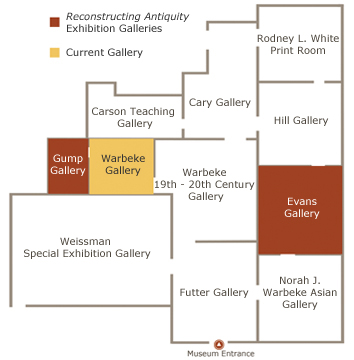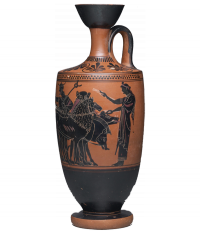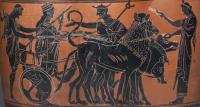Apollo mounting a chariot drawn by lions and boars, accompanied by Hermes and two women
Learn more about the object below
In most Greek art, when lions and boars appear depicted together, the lion is portrayed as the victor, the boar as the defeated. The two are rarely seen in such close quarters as here, hitched to the same chariot. The odd pair derive from the myth of Alcestis, whose father would only allow a suitor to court her if he could harness the two beasts together. With help from Apollo, Admetus was able to do so, but a deal with Fate took Alcestis’ life. The scene depicts the beasts already hitched, suggesting Alcestis and Admetus’ story is in mid-action.
Hermes, shown with his caduceus and his traveler’s cap, ushered the dead from the land of the living. The youthful Alcestis gave up her life for that of her sick husband, Admetus, when Apollo struck a deal with the Fates: to take a life for a life and spare Admetus. Ultimately, it is Hermes who takes Alcestis to Hades, where legend has it, Herakles awaits and saves her, bringing her back to her husband. The myth would suggest that the identity of the woman standing behind the chariot is the crowned and recently married Alcestis who must follow Hermes to the Underworld.
Label text by Margaret Swanson (MHC, '12)
Suggested readings:
Euripides, Alcestis, translated by Richard Aldington (London: Chatto & Windus, 1930)
Karl Schefold, Gods and Heroes in Late Archaic Greek Art (University of Cambridge Press, 1992). 102-106, 269-298.
Emily Vermeule, Aspects of Death in Early Greek Art and Poetry, Sather Classical Lectures, Vol. 46





